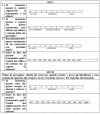Italian validation of the credibility/expectancy questionnaire in spinal pain: a useful tool for clinicians and physiotherapist (CEQ-I)
- PMID: 40546309
- PMCID: PMC12182615
- DOI: 10.1177/20406223251324812
Italian validation of the credibility/expectancy questionnaire in spinal pain: a useful tool for clinicians and physiotherapist (CEQ-I)
Abstract
Background: The "credibility" and "expectation" regarding the treatment are important factors in the rehabilitation management of patients with spinal pain (SP).
Objectives: The aim of this study was to translate, culturally adapt, and validate an Italian version of the credibility/expectancy questionnaire (CEQ-I) by Devilly and Borkovec (CEQ) for its application in SP in rehabilitative care.
Design: Cross-sectional observational study.
Methods: Ninety-nine patients (N = 99; mean age of 56.9 years ± 16.3 SD) with acute or chronic SP were recruited from September 2023 to September 2024. To evaluate construct validity, exploratory factor analysis (EFA) was conducted using a matrix of polychoric correlations along with promax rotation. The internal consistency and stability of the scale were evaluated using Cronbach's alpha coefficient and test-retest analysis through the intraclass correlation coefficient (ICC). Pearson's analysis between CEQ and other scales (Numeric Rating Scale, NRS; Roland and Morris-Disability Questionnaire, RMDQ; Oswestry Disability Index, ODI; Neuropathic Pain Symptom Inventory, NPSI) was employed to assess external validity.
Results: Ninety-nine subjects were recruited. Test-retest reliability between two consecutive administrations of the CEQ showed an ICC of 0.90 (p < 0.001). The Kaiser-Meyer-Olkin (KMO) statistic was 0.81, indicating suitability for factor analysis. EFA revealed two factors-credibility and expectancy-accounting for 56.6% of the variance. Cronbach's alpha indicated high internal consistency (0.85). External validation using Pearson's correlation found no significant relationships between the CEQ subscale scores and NRS, RMDQ, ODI, and NPSI scales.
Conclusion: The CEQ-I is a valid Italian translation of CEQ that demonstrates acceptable psychometric properties in SP in a rehabilitative setting. However, we recommend further analysis of the construct definition of the CEQ-I.
Keywords: credibility; expectation; outcome measure; psychotherapy; rehabilitation; routine practice; validation.
Plain language summary
A practical tool for assessing spinal pain: the Italian validation of the credibility questionnaire (CEQ-I) In rehabilitative medicine, clinical scales and tests are indispensable tools for objectively and reliably measuring specific aspects concerning patients (e.g., strength, tone, pain, etc.). For their application in a population with a different language from that of origin, they must undergo formal approval (validation) through studies that meet international reference criteria. Our study aims to “validate” an important English scale in the clinical management of spinal pain, to facilitate clinical practice and research in the field. To do this, we asked 99 patients who visited the physiotherapy outpatient clinics at the research sites to respond to questions translated into Italian from the original English scale (CEQ scale by Devilly & Borkovec), which assesses the credibility and expectations of the patient regarding the rehabilitation treatment they are about to undergo. The study was conducted by applying statistical analysis to the data, which highlighted a strong correspondence between the questions asked and the expectations and feelings of the patients towards the prescribed therapies, as well as alignment with the original test. Therefore, we concluded that our translation is valid, providing a new tool that is easy to use and precise, to assist the Italian rehabilitation community in carrying out its work.
© The Author(s), 2025.
Figures
Similar articles
-
Translation and Psychometric Validation of Brief Illness Perception Questionnaire: The Urdu Version for Facilitating Multidisciplinary Research in Pakistan.J Multidiscip Healthc. 2025 Aug 20;18:5075-5088. doi: 10.2147/JMDH.S536636. eCollection 2025. J Multidiscip Healthc. 2025. PMID: 40862264 Free PMC article.
-
Psychometric properties of the Chinese version of the pros and cons of anorexia nervosa (P-CAN-C) scale: a validation study in patients with anorexia nervosa.J Eat Disord. 2025 Jun 16;13(1):111. doi: 10.1186/s40337-025-01314-x. J Eat Disord. 2025. PMID: 40524259 Free PMC article.
-
Maternal and neonatal outcomes of elective induction of labor.Evid Rep Technol Assess (Full Rep). 2009 Mar;(176):1-257. Evid Rep Technol Assess (Full Rep). 2009. PMID: 19408970 Free PMC article.
-
Adaptation and validation of the Chinese version of the digital addiction scale for children (DASC).BMC Public Health. 2025 Jul 30;25(1):2599. doi: 10.1186/s12889-025-23817-7. BMC Public Health. 2025. PMID: 40739489 Free PMC article.
-
Signs and symptoms to determine if a patient presenting in primary care or hospital outpatient settings has COVID-19.Cochrane Database Syst Rev. 2022 May 20;5(5):CD013665. doi: 10.1002/14651858.CD013665.pub3. Cochrane Database Syst Rev. 2022. PMID: 35593186 Free PMC article.
References
-
- Flynn DM. Chronic musculoskeletal pain: nonpharmacologic, noninvasive treatments. Am Fam Physician 2020; 102(8): 465–477. - PubMed
-
- Zaina F, Côté P, Cancelliere C, et al. A systematic review of clinical practice guidelines for persons with non-specific low back pain with and without radiculopathy: identification of best evidence for rehabilitation to develop the WHO’s Package of interventions for rehabilitation. Arch Phys Med Rehabil 2023; 104(11): 1913–1927. - PubMed
-
- Hylands-White N, Duarte RV, Raphael JH. An overview of treatment approaches for chronic pain management. Rheumatol Int 2017; 37(1): 29–42. - PubMed
-
- Essery R, Geraghty AW, Kirby S, et al. Predictors of adherence to home-based physical therapies: a systematic review. Disabil Rehabil 2017; 39(6): 519–534. - PubMed
-
- Wulf G, Lewthwaite R. Optimizing performance through intrinsic motivation and attention for learning: the OPTIMAL theory of motor learning. Psychon Bull Rev 2016; 23(5): 1382–1414. - PubMed
LinkOut - more resources
Full Text Sources



